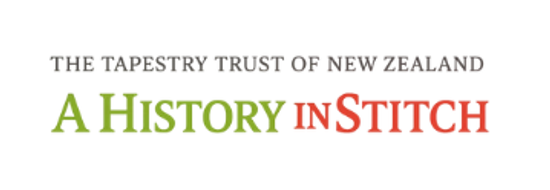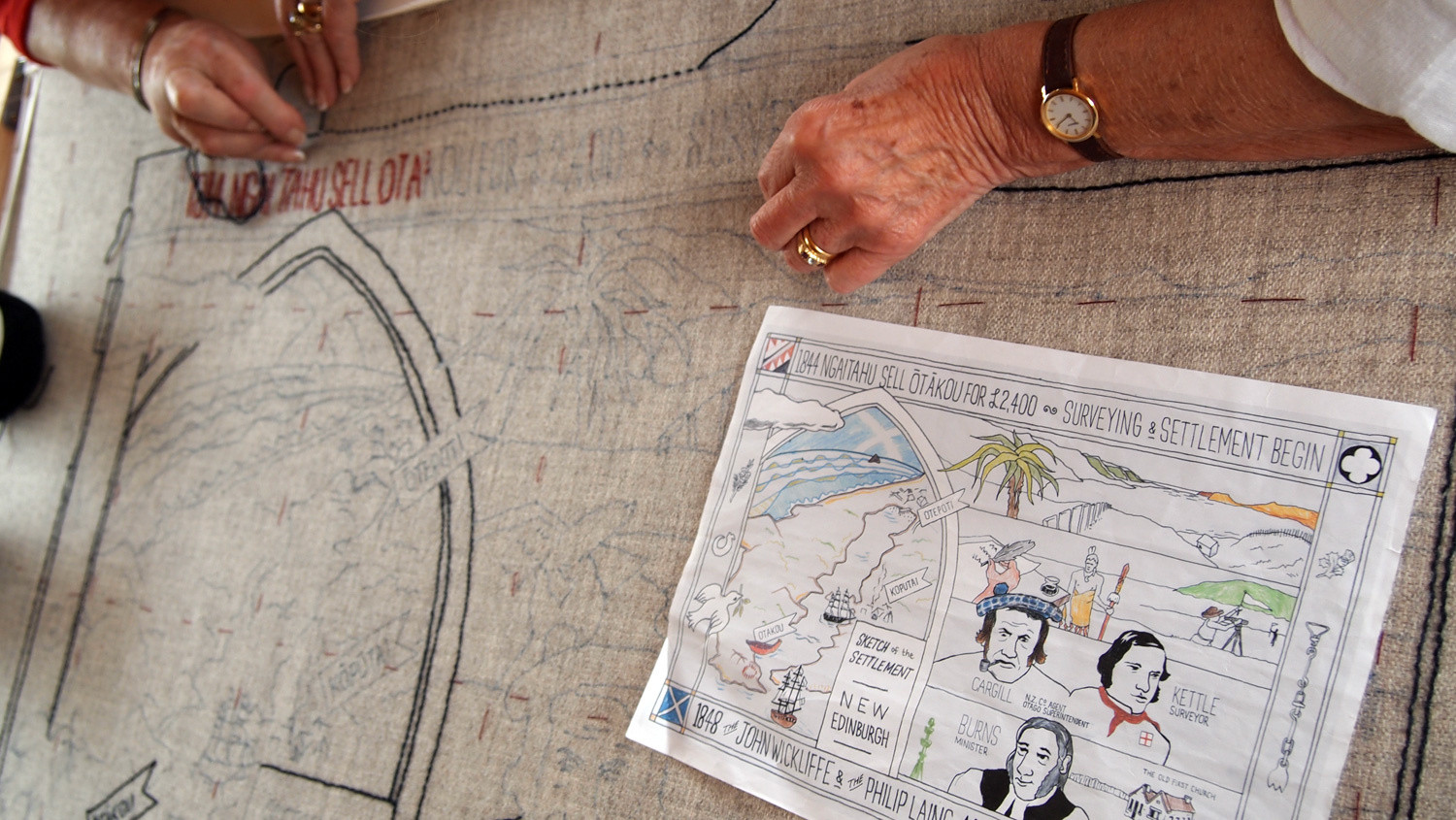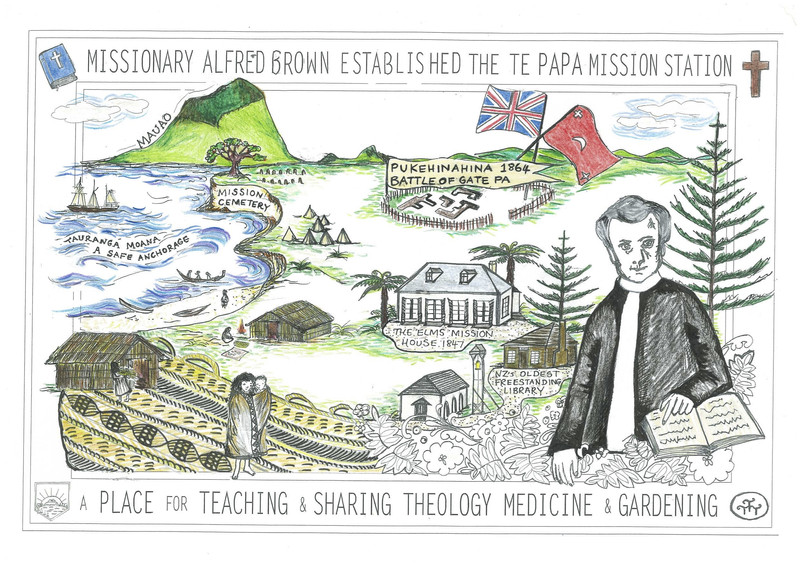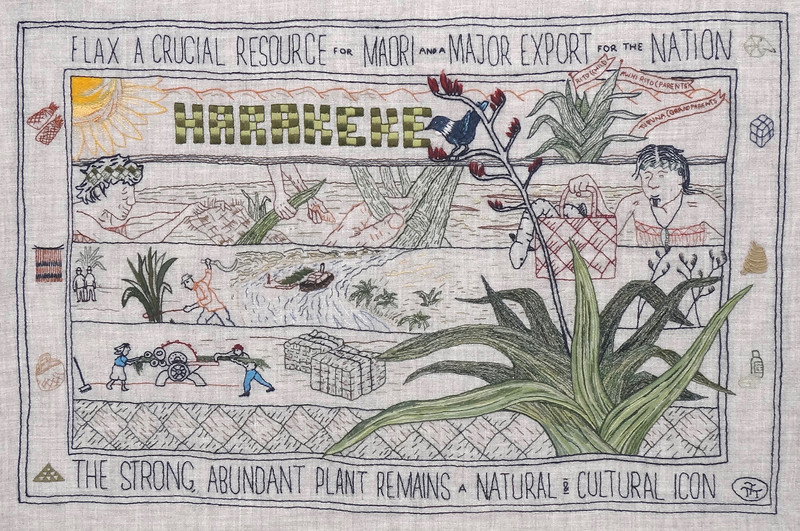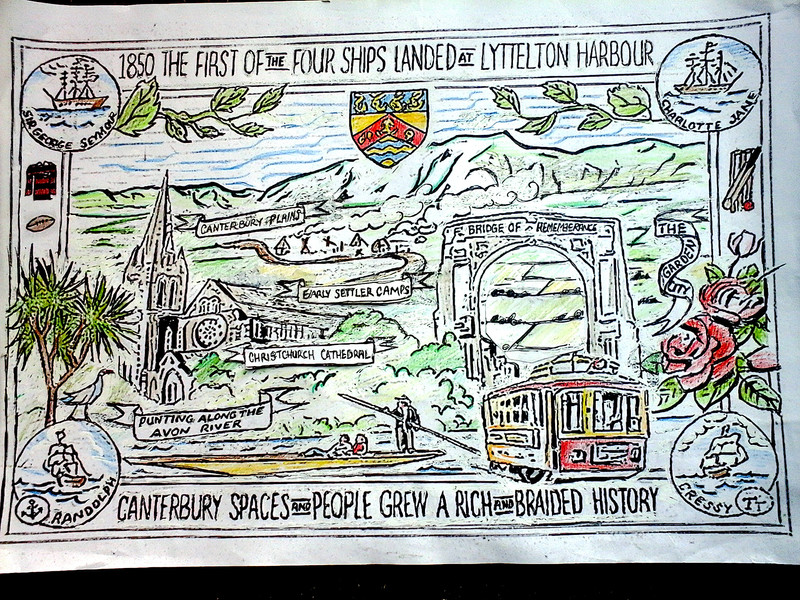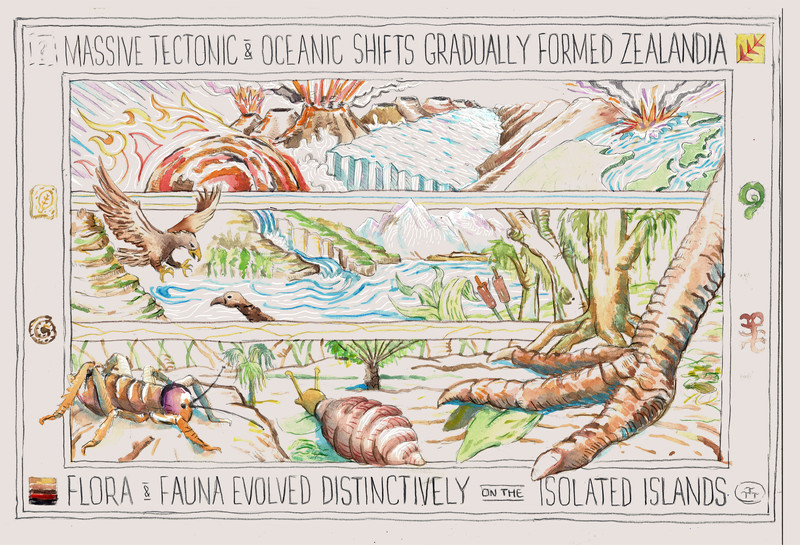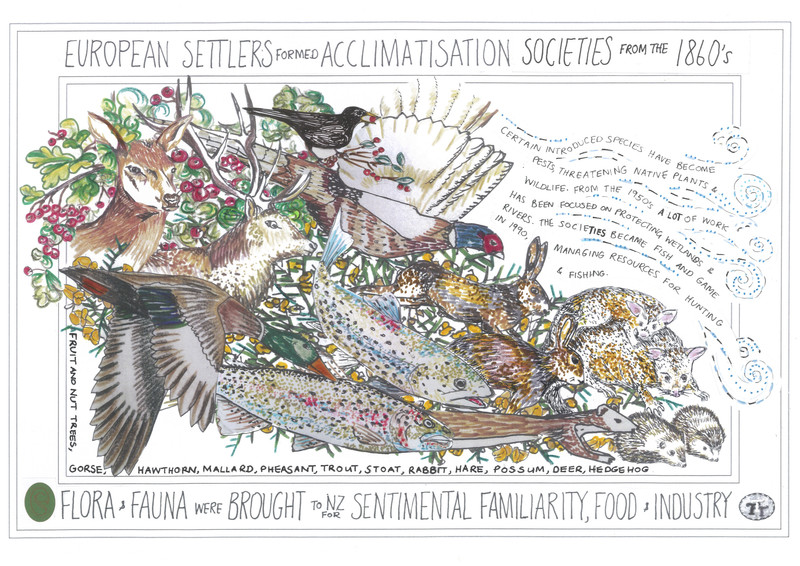The Panels
Final designs are coloured to guide the stitchers in their work. Information about the subject together with a copy of the design and the stitchers’ names are displayed with each panel when it is finally completed.
The Elms Mission Station
Te Papa Mission Station was formally established in 1838 under the leadership of missionary Alfred Brown (1803-1884). In 1874 Brown and his second wife Christina purchased the mission house and surrounding land from the Church Missionary Society. They renamed their private home The Elms, after the trees growing there.
Guild stitchers have been invited twice to stitch on the panel in the Fencible Cottage that is part of The Elms complex. This offered an opportunity to follow in the footsteps of local woman who stitched in the same room in the late 19th century.
Today, The Elms foundation ensures The Elms / Te Papa Tauranga is preserved and promoted for future generations. This tapestry recognises Tauranga’s local history.
Contributing to the stitching of this project – Marion Bennett, Janine Bigwood, Anna Broom, Faye Brown, Karen Burningham, Margaret Cannegieter, Barbara Doughty, Sally de Fluitier, Sherryl Hunt, Linda Inglis, Faye Laing, Sue Lee, Christine Knowles, Pat Macdonald, Kay McConachie, Lavinia Paine, Juliet Pearson, Carol Roband, Grace Saunders, Jennifer Thomas, Anne Thompson, Jenny Williams, Liz Wilson
Project started 2017 -2019
Artist : Georgina Dennett
Flax and the Flax Trade
Your eye is drawn towards the large flowering harakeke and tui to the right, then to the smaller detail of the cultivation, processing and use of the resource. The flax industry was nationwide, and an exclusively Māori enterprise, as the harakeke was grown by local tribes, processed by them (scraped to release its Muka), and shipped off to Sydney where it was made into rope.
Contributing to the stitching of this project – Ingrid Ames, Jean Arnott, Judith Balchin, Vivianne Barling, Sue Berington, Margaret Berryman, Ann Bridson, Bev Burgess, Maree Burnard, Margaret Butterworth, Jill Cash, Jan Conley, Cynthie Coutts, Janice Cunial, Pam Darney, Maureen Dobbin, Rosalie Drummond, Judy Eagle, Jorja Eldershaw, Eileen Fitzpatrick, Libby Francis, Mary Garlick, Judy Greenwood, Johannah Haaijema, Ann Halliday, Janet Heaven, Bev Hine, Anne Holloway, Dorothy Hughes, Glenis Jackson, Shirley Julian, Edna Law, Lynn Leask, Diane Lithgow, Elizabeth Martin, Fiona Martin, Margaret Martin, Susannah Martin, Carol McFetridge, Esther McIvor, Ann Morgan, Ngaire Morgan, Margaret Morris, Pauline Muirhead, Alison Newell, Heather Payne, Margaret Pemberton, Jan Pepperell, Heather Radfold, Karen Ralph, Pauline Ranford, Ann Reeves, Karen Richardson, Lorraine Ridgway, Elayne Robertson, Yvonne Simonds, Delwyn Singh, Gail Thompson, Rosalind Thomson, Colleen Webster, Lee Westfield, Lynne Whalley, Agnes Williams, Felicity Willis, Heather Williamson, Robin Williamson, Sue Wilson
Project started February 2015 and completed December 2016 Artist : Alex Gilks
Sponsors : Manawatu Area Embroiderers
The Foundation of Canterbury
The Canterbury region was first settled by Maori in about the 10th century. It is thought that there were probably about 500 Ngai Tahu people living in the area when the first Europeans arrived in the 1840s. The Maori history in the region is rich and varied.
Whalers and sealers were present from the early 1830s and worked from the harbours of Banks Peninsula. When news of the whaling successes of the French whalers reached France colonists were sent out with the promise of land. Thus the settlement of Akaroa was developed.
Before settlement by Europeans the area now occupied by the Christchurch was swampy with patches of marshland, scrub and grassland. The first Europeans to be established in the area were the Deans brothers who developed a farm called Riccarton. In 1848 the New Zealand Company obtained land from Ngai Tahu and in 1850 the Canterbury Association brought out 792 settlers in the four ships shown on the tapestry. Christchurch has been known as the British City or Garden City because of the heritage of the early British settlers.
Contributing to the stitching of this project were members of Canterbury Embroiderers Guild
Project completed 2024
Artist : D Mead
Primaeval New Zealand
Looking at the panel your eye is drawn to the detail of the large claw, from some kind of huge bird, perhaps a moa, a type of large air breathing snail found only in New Zealand, and a weta, which is a giant flightless cricket, one of the heaviest insects in the world. Because of our isolation, we have many creatures which are endemic to New Zealand. Each has been very imaginatively embroidered on this panel. Many members have enjoyed stitching on the panel.
Contributing to the stitching of this project –Raewyn Alderton, Noeline Becker, Vicki Craig, Margaret Denton, Maxine Diffey, Jenni Douglas, Nellie Engels, Pamela Etheridge, Anne Groos, Sophie Hancock, Janice Hartree, Barbara Hilford, Chris Jacobs, Margaret Jowett, Val Pudney, Jenny Shattock, Neville Simons, Colleen Small, Irene Stirling, Jean Teao, Olive Thornton, Diana Valentine, Diane Wayne, Cathy Williams, Rita Williams
Project started Feb 2016 and completed Oct 2019
Artist : Alex Gilks
Sponsors : Margaret Denton
Acclimatisation in New Zealand
When the first European settlers arrived in New Zealand in the early 19th century they brought with them a few animals and plants to help them set themselves up in their new homeland. From the 1860s acclimatisation societies were set up to naturalise the new species provided they would have no harmful effect. Some local governments provided small grants to assist with the process.
In 1903 a formal association of acclimatisation societies was agreed to at their annual meeting in Wellington and thus the New Zealand Acclimatisation Society was formed.
Introduced species included many varieties of small garden birds, brown and rainbow trout, deer, mallard ducks, hares and hedgehogs. Rabbits were introduced successfully by about 1852 but between 1883 and 1892 stoats were being imported by both the government and private citizens in an effort to control the rapidly growing rabbit population. This is an ongoing task.
Contributing to the stitching of this project – Pearl Hogg, Marion Falconer, Jean Young, Heather Walker, Glenice Terry, Rosalie Walis, Margaret Wilson, Kevin McCartny, Juliette Carvallee, Wendy Goodwin, Valmai Redhead, Eleanor Wilson, Pam Mackenzie, Colin Dewe, Kobi Rosshard, Leone Beatson, Daphne Cross, Tania Matthews, Mary Laird, Bernice Mills, Isabel Smith, Lynette Mercer, Joan Gerven, Margaret Erskine
Project completed 20 May 2024
Artist : Georgina Dennett
